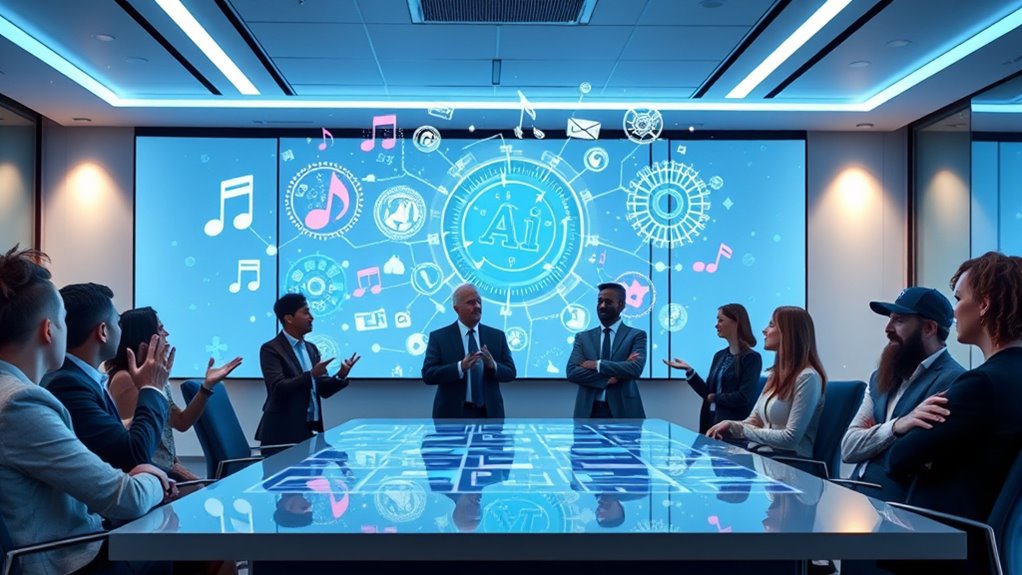AI is transforming IP licensing in music and film by speeding up content creation and streamlining licensing processes. However, it also raises complex questions about ownership, rights, and legal clarity, since AI-generated works blur traditional attribution models. Managing these changes requires adapting existing laws and developing new licensing frameworks that ensure transparency and fairness. To understand how these shifts impact creators and industries alike, keep exploring the evolving landscape of AI’s influence on licensing.
Key Takeaways
- AI accelerates licensing processes but complicates rights attribution and ownership, leading to legal uncertainties.
- AI-generated content blurs traditional rights boundaries, raising questions about ownership and appropriate compensation.
- Existing legal frameworks struggle to accommodate AI-created works, creating licensing gray areas and potential disputes.
- Verifying provenance and ensuring AI respects licensing restrictions become more complex with machine-produced content.
- Adaptation of licensing models and rights management systems is essential to address AI’s evolving impact on intellectual property.

Artificial intelligence is transforming how music and film licensing works, making the process faster and more efficient. With AI-generated content becoming increasingly common, you now have tools that can produce music, visuals, and even entire scenes in a matter of moments. This technological leap streamlines content creation, but it also introduces complex licensing challenges. When AI generates content that resembles existing works or combines elements from multiple sources, you might find it difficult to determine who owns the rights or who should be compensated. This ambiguity complicates licensing agreements, as traditional rights management models aren’t fully equipped to handle AI-created materials. You could face questions about originality, authorship, and copyright ownership, especially when the lines between human and machine contributions blur.
Navigating these licensing challenges requires a clear understanding of how AI-generated content fits into existing legal frameworks. For example, if an AI system creates a new piece of music, you need to decide whether the copyright belongs to the developer of the AI, the user who prompted it, or the AI itself. Current laws are often unclear on whether AI can hold rights, leaving licensing agreements in a gray area. This uncertainty can slow down negotiations and lead to disputes over attribution and royalties. You might also have to contend with licensing existing content fed into AI systems, which can sometimes infringe on copyright if not properly managed. Ensuring that AI tools respect licensing restrictions and that content creators are fairly compensated becomes a central concern. Additionally, the increasing use of AI in content creation highlights the importance of robust rights management systems to handle the evolving landscape.
Furthermore, the proliferation of AI-generated content raises questions about originality and authenticity. When content is machine-produced, it’s harder to verify its provenance or determine if it infringes on someone’s intellectual property. This can increase licensing challenges, as you must verify that content doesn’t violate existing rights before using or distributing it. To address these issues, licensing models are evolving to incorporate AI-specific clauses, but implementation is still in progress. You may find yourself needing to work with rights organizations or develop new agreements tailored to AI-generated works. Ultimately, embracing these changes requires staying informed about legal developments and being proactive in managing rights, ensuring that licensing remains fair and transparent as AI continues to reshape the creative landscape.
Frequently Asked Questions
How Does AI Influence Existing Licensing Agreements in Music and Film?
AI influences your licensing agreements by raising questions about AI ownership of creative works, which can complicate rights management. You might face increased copyright disputes as AI-generated content blurs traditional boundaries of authorship. This impacts how you negotiate licenses, ensuring you’re clear about rights and ownership. Staying updated on AI’s role helps you protect your assets and navigate evolving legal landscapes effectively.
What Legal Challenges Arise From Ai-Generated Content Rights?
Imagine you’re in a sci-fi movie, but here, the main plot revolves around authorship disputes and copyright ownership. AI-generated content raises legal challenges because it’s unclear who owns the rights—the creator, the user, or the AI itself. You face issues like establishing authorship and protecting intellectual property. These disputes could lead to lengthy legal battles, complicating licensing and potentially stifling innovation in music and film.
Can AI Predict Future Licensing Trends in Entertainment Industries?
Yes, AI can predict future licensing trends in entertainment industries through predictive analytics and trend forecasting. You can leverage these tools to analyze data patterns, consumer preferences, and market shifts, giving you valuable insights. This allows you to anticipate changes in licensing demands, optimize content distribution, and stay ahead of competitors. AI’s ability to process vast amounts of data makes it an effective asset for strategic planning and decision-making in entertainment licensing.
How Are Licensing Fees Affected by Ai-Driven Content Creation?
You might think AI’s a game-changer, but it’s really just tweaking licensing fees. As AI-driven content creation blurs lines, royalty negotiations become trickier, often leading to lower fees for creators or unexpected costs for studios. Content monetization shifts as AI churns out endless material, forcing everyone to rethink fair compensation. So, buckle up—AI’s impact on licensing fees is less about fairness and more about steering a wild, unpredictable ride.
What Role Does AI Play in Enforcing Licensing Compliance?
AI plays a vital role in enforcing licensing compliance by using automated monitoring to track unauthorized use of content. It employs digital watermarking to embed invisible identifiers, making it easier to detect infringement. You can rely on AI to scan platforms continuously, identify violations quickly, and alert you to unauthorized distribution, helping you protect your rights efficiently and guarantee licensing terms are respected without manual oversight.
Conclusion
As you embrace AI’s role in music and film licensing, it’s clear this technology revolutionizes how content is created and shared. Did you know that AI-generated music is expected to account for over 30% of all new compositions by 2030? This shift challenges traditional licensing models, pushing you to adapt and innovate. Staying informed and flexible guarantees you can navigate these changes, leveraging AI’s potential to shape the future of intellectual property in entertainment.








